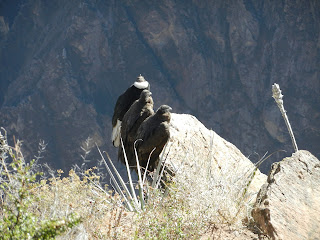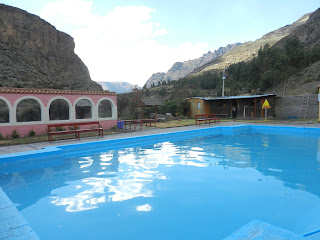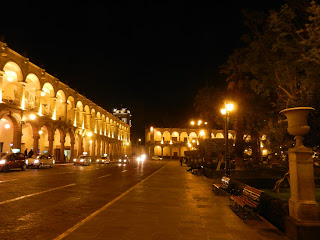After that we continued another 40 minutes or so to Cabanocade (will check spelling as can't remember exactly) where we began our hike.
Driving along the canyon you got a sense of just how deep it is, but until we had actually trekked from the top to the bottom, I'm not sure we really knew what 1200m of vertical felt like. It was definitely a tough hike and a little treacherous at times, but we made it through! (You can see part of the path in the pictures below)
After lunch and a short rest, we walked along a flat area for a bit then headed uphill for a short while. From that point on things got much easier and it was a more normal hike for the rest of the 3 hours. We walked through two tiny towns (names to come later as I cant remember) and then descended again, but this time to The Oasis where we would be spending the night in one of the cabins.
In total, this took around 7 hours (we got there around 5) and we were definitely feeling it when we arrived at camp. The place we stayed was extremely basic (ie no electricity and one bathroom), but we were so tired and so excited about going to sleep it hardly mattered. It was cute though and had a swimming pool, so we took a quick dip to get the dust off of us then changed and looked at the stars until it was time for dinner at 7. The brilliance and visibility of the stars was one of the best parts I think-- it was unbelievably clear down in the valley and we could see the milky way and more stars than I had ever seen (including our western road trip). When we were at a museum in Cusco, we learned that the incas looked at the spaces between stars instead of connecting the dots to see shapes in the heavens. One of these was a llama and amazingly we were able to locate it- pretty awesome.
We had a semolina soup for dinner followed by alpaca/rice and chocolate pudding by which point we were more than ready to pass out so we said goodnight to Lucia and tucked in for the chilly night. We woke the next morning at 5:40 which strangely felt like sleeping in and met up with John who provided us with mules to take us out of the canyon. Neither of us had ridden mules before so it was a bit of an adventure but we obviously made it! It took about an hour and a half for us to get out and we were with another family who happened to be French. They sent the mom and oldest daughter out first, well ahead of Brennan and me and the two other daughters. One of the girls was young, probably seven or so, and she ended up on a fairly spirited donkey who passed Brennan and then kept trying to pass me. The girl was understandably upset that her donkey was trying to go faster and she and I were both very nervous which didn't help matters. Eventually the guide switched donkeys with her and tied hers to his which calmed her down but there were many exchanges between the two of us that went something like: madame, madame, plus rapide s'I'll vous plait! An adventure to say the least!
One of the best parts of the trip was definitely our wonderful guide, Lucia. Throughout the trek she was able to provide interesting things to know about the area; I'll include some of them here with no particular organization:
The canyon had two different cultures before the incas that distinguished themselves by their primary god, which was based on nearby volcanoes. One volcano was pointy and the other was flatter; originally they modified the skulls of their children to more closely resemble these shapes but ended up wearing two different kinds of hats as the modification was obviously dangerous.
The small towns in the valley keep getting smaller as all the young people leave since there's no opportunity for them. The school only covers through primary and have only about 20 kids total. If they want to continue past this, they go live with people their families know outside the canyon or better off families may send their kids to arequipa or lima with friends and family there. There is a rough road being built to that side of the valley, but it may be a case of both a blessing and a curse.
She showed us aloe vera as well as other medicinal herbs and plants found in the valley. They had to be self sustaining since it's so remote so this was obviously important. She also told us about the different grains they grow as well as vegetables. Apparently quinoa fetches a good export price due to the europeans and americans, so most peruvians don't eat it frequently anymore since its more valuable to sell it. We also saw avocadoes, pomegranates, and an abundance of cactus. Apparently a parasite that lives on cactus during certain times of the year is one of the areas most valuable crops-- its used in all sorts of dyes including lipstick and other cosmetics and is worth a lot on the international market.
Where the town of maca sits was originally a lake, but with the earthquakes, the lake drained off and helped create the canyon and the river. You can see the fault line/divide from the last major earthquake in the hillside.


































No comments:
Post a Comment